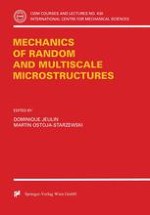2001 | OriginalPaper | Buchkapitel
Mechanics of Random Materials
Stochastics, Scale Effects and Computation
verfasst von : M. Ostoja-Starzewski
Erschienen in: Mechanics of Random and Multiscale Microstructures
Verlag: Springer Vienna
Enthalten in: Professional Book Archive
Aktivieren Sie unsere intelligente Suche, um passende Fachinhalte oder Patente zu finden.
Wählen Sie Textabschnitte aus um mit Künstlicher Intelligenz passenden Patente zu finden. powered by
Markieren Sie Textabschnitte, um KI-gestützt weitere passende Inhalte zu finden. powered by
These notes provide an introduction to three aspects of mechanics of materials with random and multiscale microstructures: stochastic tools, scale effects in constitutive response, and computational methods. The overriding objective in the first Section (Basic Probability Tools) is to give an account of tools of probability theory and random (or so-called stochastic) processes — admittedly a vast subject area per se — at a level sufficient to describe non-deterministic, spatial material fluctuations. An attempt is made here to present random processes as objects parametrized by space coordinates, rather than time. The latter viewpoint is classical throughout most of the literature on random processes, but ours allows a natural generalization to random fields. Indeed, from that standpoint, each and every material microstructure may be considered a random field, although, as pointed out in the chapter by D. Jeulin, a different modeling strategy — based, say, on mathematical morphology — may be more suitable. The presentation covers scalar and vector processes and fields, all illustrated by measurements of paper mechanical properties. This introduces basic concepts of wide-sense stationarity and ergodicity, and sets the base for analyses of random continua.The second section (Continuum Mechanics of Random Media), central to this chapter, focuses on the problem of Representative Volume Element (RVE) in the sense of Hill (1963). This is, in essence, the problem of coupled size and boundary condition dependence of constitutive response of microstructures described by random fields. Indeed, given three possible types of boundary conditions, we have three possible apparent responses, two of which (kinematic- and traction-controlled) hound on mesoscale the effective (in the macroscopic sense) response. The mesoscale domain involved is called a Statistical Volume Element (SVE). A review is provided here of the results obtained in this field over the past dozen years. We first study hierarchies of mesoscale bounds for elastic microstructures: both qualitative results via variational principles and quantitative results-via computational mechanics. The same type of approach is then sketched for inelastic microstructures, although a much wider range of results is given in the elastic case. This chapter culminates in a short review of two topics in wave propagation in random media: spectral finite elements and wavefront propagation. Here the wave length, respectively wavefront thickness, again introduces an SVE in place of an RVE.The third section (Some Computational Mechanics Methods for Random Media) directly builds on, and supports, the second one. On one hand, it is shown how the mesoscale bounds can be used as input into the finite element methods, thus leading to micromechanics-based stochastic finite elements. The semblance, as well as contradistinction, of this approach to conventional finite elements and conventional random field models of continua is discussed. On the other hand; we provide a very brief introduction into spring network models, heavily favored by this author for rapid computation of statistics of mesoscale bounds of elastic materials, based on Monte Carlo-type generation of their random microstructures.
